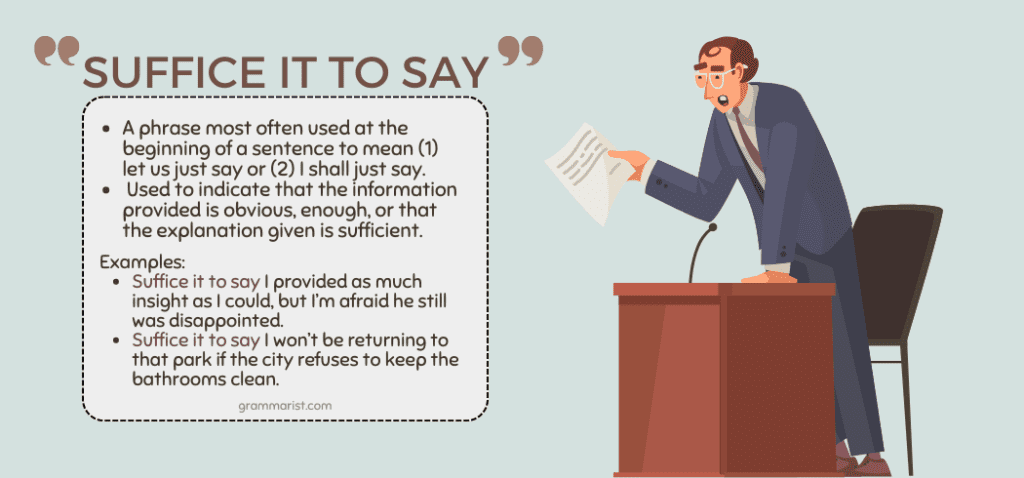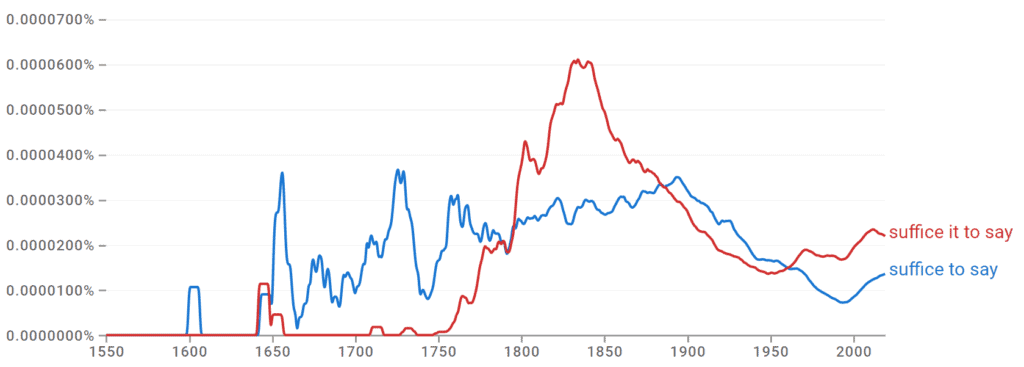Want to point out to someone that what you have to say is obvious and doesn’t require added explanation? The phrase suffice it to say is the addition you are looking for and allows your audience to understand that what you’ve already said is more than enough.
If you are worried that the phrase sounds a bit snarky, don’t be. Although it can be used to create a sarcastic tone, it also works well to simply draw attention to what has already been mentioned.
Take a look at what this phrase means and how you can best use it to create tone and focus.
What Is the Meaning of Suffice It to Say?

Suffice it to say is a phrase most often used at the beginning of a sentence to mean (1) let us just say or (2) I shall just say. It is the subjunctive form of the phrase it suffices to say. Its use indicates that the information provided is obvious, enough, or that the explanation given is sufficient.
For example:
- Suffice it to say I provided as much insight as I could, but I’m afraid he still was disappointed.
A person who uses the term may use it to create a sarcastic or condescending tone that hints more information could be available, but the statement provided is enough.
For example:
- Suffice it to say that you’ve been given the refund, and no more action will be taken by the establishment as we consider the situation resolved.
You can also use suffice it to say to indicate humor or to emphasize that what follows is an understatement.
For example:
- Suffice it to say the dog did not enjoy her first night in the kennel if the dark circles under my eyes are any indication.
How to Use Suffice It to Say
Suffice it to say is most often affixed to the beginning of any declarative sentence or clause. It is commonly followed with the word “that,” but it is not necessary for proper grammar use. The phrase also does not need to be followed with a comma.
For example:
- Suffice it to say I won’t be returning to that park if the city refuses to keep the bathrooms clean.
It is not used in sentences other than declarative and does not have a grammatically correct interrogative use.
It also can be placed in the middle of a sentence in order to create emphasis. When used in this manner, you want to set it aside with commas.
For example:
- He extended the business trip through their anniversary and, suffice it to say, had some serious explaining to do when he got home.
Suffice to Say or Suffice It to Say?

The phrase is sometimes shortened to suffice to say. This shortened version is an acceptable use and has been around for as long as the sentence construction of the subject + “suffice” + “to” + an infinitive has been used.
Origin of Suffice It to Say
Suffice it to say originates from the 12th-century Latin verb sufficere, meaning to be sufficient or adequate.
It was widely used in 14th-century England, recorded in Shakespeare’s Taming of the Shrew:
- “’twixt such friends as wee, / Few words suffice.”
It also was used by Sir Thomas More, recorded in 1528:
- “Yet yf he lacked charite, all hys fayth suffised not.”
The Oxford English Dictionary quotes poet John Dryden in 1692 with it suffices to say, with the subjunctive suffice it to say becoming more popular in the 18th and 19th centuries.
Let’s Review
Suffice it to say is a phrase that indicates that what has been said is adequate and that further information isn’t needed. Depending on its placement and context, it can be used to simply explain that enough information has already been shared or to create emphasis, humor, or even sarcasm.

Comments are closed.